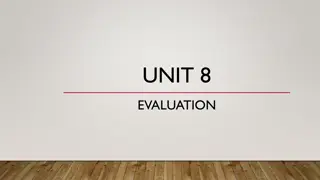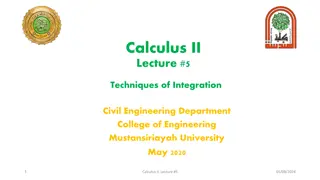Asymptotic Evaluation Techniques in Integral Calculus
Learn about asymptotic evaluation of integrals through techniques like integration by parts and the stationary-phase method. Understand how to handle integrals involving real functions, and grasp the significance of concepts like the Riemann-Lebesgue lemma and small o notation. Delve into the physical interpretations and applications of these methods for solving complex integrals.
- Integral Calculus
- Asymptotic Evaluation
- Integration by Parts
- Stationary-Phase Method
- Riemann-Lebesgue Lemma
Download Presentation

Please find below an Image/Link to download the presentation.
The content on the website is provided AS IS for your information and personal use only. It may not be sold, licensed, or shared on other websites without obtaining consent from the author. Download presentation by click this link. If you encounter any issues during the download, it is possible that the publisher has removed the file from their server.
E N D
Presentation Transcript
ECE 6341 Spring 2016 Prof. David R. Jackson ECE Dept. Notes 28 1
Asymptotic Evaluation of Integral Goal: Evaluate the following integral as becomes large: b ( ) ( ) f x e ( ) = j g x I dx g(x) is a real function here. a ( ) ( ) g x 0, , x a b Integration by Parts Case 1: ( ) g x = 0, , x a b Stationary-Phase Method Case 2: 0 0 2
Integration by Parts b ( ) ( ) f x e ( ) = j g x I dx a ( ) g x 0 , x a b Note that d dx ( ) ( ) j g x e = j g x j g x ( ) ( ) e So that we may write 1 g x dx d b ( ) = ( ) f x j g x ( ) I e dx ( ) j a 3
Integration by Parts 1 g x dx d b ( ) = ( ) f x j g x ( ) I e dx ( ) j a v u d dx d dx b b ( ) u x ( ) v x dx ( ) ( ) u x v x ( ) v x ( ) u x dx b = a a a Hence ( ) f x g x ( ) = b j g x ( ) I e ( ) j a ( ) ( ) f x 1 j d dx g x b j g x ( ) e dx a 4
Integration by Parts (cont.) Riemann-LebesgueLemma: b aF x e ( ) ( ) g x j 0 dx as (The integrand oscillates faster, so the integral tends to zero) Hence ( ) f x g x ( ) b j g x = + ( ) 1/ I e o ( ) j a or Small o notation: It decays faster than this as gets large. ( ) f x g x b j g x ( ) ~ I e ( ) j a 5
Integration by Parts (cont.) Physical interpretation ( ) f x g x b ( ) ( ) f x e ( ) = j g x I dx b j g x ( ) ~ I e ( ) j a a ( ) ( ) f x = ( ) g x j Re f x e Endpoint contributions remain ( ) ( ) cos g x x Interior parts cancel 6
Stationary-Phase Method b ( ) f x e ( ) = ( ) g x ( ) g x j I dx a ( ) = 0 , x a b 0 0 ( ) ( ) x 0 f x Assume 0 0 g 0 1 2 ( ) ( ) g x ( )( 0 g x ) ( )( 0 x ) 2 + + g x x x g x x 0 0 0 ( ) ( ) f x = ( ) g x j Re f x e ( ) ( ) Stationary-phase point g x cos x 0x b a 7
Stationary-Phase Method (cont.) Conjecture: + x j g x 0 ( ) ~ ( ) f x e I dx x 0 If 0 ( ) slowenough To ensure that the stationary phase point region dominates over the outside regions, we define: 1 g x dx d + + x x ( ) = ( ) f x e ( ) f x j g x j g x = 0 0 ( ) ( ) I dx e dx ( ) SPP j x x 0 0 1 g x dx d x x ( ) = ( ) f x e ( ) f x j g x j g x = 0 0 ( ) ( ) I dx e dx ( ) left j a a 1 g x dx d b b ( ) = ( ) f x e ( ) f x j g x j g x = ( ) ( ) I dx e dx ( ) right j + + x x 0 0 8
Stationary-Phase Method (cont.) We have that A A I 1 I 2 ( ) ( ) g x g x left right + 0 0 For some constants A1 and A2. Big O notation: It behaves like this as gets large. O 1 = I We will show later that SPP 9
Stationary-Phase Method (cont.) Hence, we require that 1 1 I I left right Approximating the first derivative of g by a Taylor series, ( ) 0 g x ( ) ( 0 g x ) ( ) x + g 0 We require: 1 1 ( ) x g 0 1 Hence (This needs to be one of our assumptions.) 10
Stationary-Phase Method (cont.) Hence, we assume that: This ensures that 0 + x j g x 0 ( ) ~ ( ) f x e I dx x 0 x 0x b a 2 11
Stationary-Phase Method (cont.) 0 Since ( ) f x ( ) f x Assume 0 + x j g x 0 ( ) ~ ( ) f x I e dx Hence 0 x 0 12
Stationary-Phase Method (cont.) 1 2 ( ) ( ) g x ( )( 0 g x ) ( )( 0 x ) 2 + + g x x x g x x 0 0 0 1 2 ( )2 + x x x ( ) j g x ( ) ( ) f x e j g x 0 ( ) 0 0 I e dx 0 0 x 0 or 1 2 ( )2 + x x x ( ) j g x ( ) ( ) f x e 0 ( ) 0 0 j g x I e dx 0 0 x 0 where ( ) x ( ) x = g g 0 0 13
Stationary-Phase Method (cont.) Let ( ) 2 ( ) 2 g x g x ( ) 0 0 = = s x x ds dx 0 Then 2 + S ( ) ( ) f x e 2 j g x ( ) L js I e ds 0 ( ) x 0 g S L 0 where ( ) 2 g x 0 = S L , S As since L 14
Stationary-Phase Method (cont.) Therefore + + S 2 2 L js js I e ds e ds L S L Let + 2 2 + + = = js js I e ds e ds 1 L C C Ims 1 Deform the path: 45 Res C C C 1 15
Stationary-Phase Method (cont.) Let j = = 2 2 2 s t e jt 2 j = s te 4 j = ds dte 4 Hence ( ) + 2 j j jt = I e e dt 4 1 L + j 2 = t e e dt 4 j = e 4 16
Stationary-Phase Method (cont.) Similarly, + j 2 = js LI e ds e 4 2 Then 2 j ( ) j g x ( ) f x e I e 4 0 ( ) x 0 g 0 O 1 = Note: I 17
Stationary-Phase Method (cont.) Hence 2 j ( ) j g x ( ) I f x e e 4 0 ( ) x 0 g 0 ( ) ( ) x + , 0 g x 0 , 0 g 0 18
Example 1 ( ) = ( ) d cos sin J 0 0 1Re = d sin j e 0 ( ) ( ) ( ) = = 1 f sin g ( ) g = = cos 0 0 0 = +n 0 2 19
Example (cont.) / 2 / 2 ( ) ( ) ( ) = sin = = g ( ) g = = sin 1 0 cos g 0 0 sin g Hence 1 2 j ( ) ( ) 1 j ~ Re J e e 4 0 1 20
Example (cont.) 1 2 j ( ) ( ) 1 j ~ Re J e e 4 0 1 Hence 2 ( ) ~ cos J 0 4 as 21























